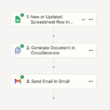Table of Contents Show
Staying aligned with your goals while ensuring that every team member is on the same page can be challenging.
This is where OKRs, or Objectives and Key Results, come into play.
Originating in the 1970s and popularized by tech giants like Google, OKRs have become a cornerstone for many organizations seeking to improve performance, foster transparency, and drive strategic alignment.
This blog will delve into the OKR framework, exploring its definition, structure, benefits, and best practices for implementation.
What are OKRs?
OKRs, or Objectives and Key Results, is a goal-setting framework used to define and track objectives and their outcomes.
Objectives are the “what” – the goals you want to achieve, which should be significant, concrete, and action-oriented.
Key Results are the “how” – specific, measurable outcomes that, if achieved, will help you attain your objective.
Purpose of OKRs
The primary purpose of OKRs is to ensure that everyone in an organization is working towards the same goals.
By clearly defining objectives and key results, OKRs provide a roadmap for success, ensuring that all team members understand their roles and responsibilities in achieving these goals.
This alignment not only boosts productivity but also fosters a sense of purpose and engagement among employees.
The OKR Framework
Structure of OKRs
Creating effective OKRs involves formulating clear, concise objectives and measurable key results. Objectives should be ambitious yet achievable, providing a clear direction and motivating teams to strive for excellence. Key results should be specific, time-bound, and quantifiable, allowing for easy tracking and assessment.
OKR Cycle
OKRs typically operate on a quarterly cycle, allowing for regular planning, tracking, and reviewing. This cycle involves setting OKRs at the beginning of the quarter, conducting regular check-ins to monitor progress, and reviewing outcomes at the end of the quarter. This iterative process ensures continuous improvement and adaptability.
Setting OKRs
When setting OKRs, it’s essential to strike a balance between ambition and realism. Objectives should be challenging enough to inspire growth but not so unrealistic that they become demotivating. Examples of well-structured OKRs might include a sales team aiming to “Increase quarterly revenue by 20%” (Objective) through “Launching three new marketing campaigns” and “Expanding into two new markets” (Key Results).
Types of OKRs
OKRs, or Objectives and Key Results, can be categorized into various types based on their application, scope, and organizational structure. Understanding these types helps tailor OKR strategies to meet specific goals and improve overall performance. Here’s a detailed look at the different types of OKRs:
1. Personal OKRs
Personal OKRs are set by individuals to drive their personal and professional growth. These OKRs focus on self-improvement, skill development, and personal milestones. Personal OKRs help individuals align their goals with their career aspirations and organizational objectives.
Examples of Personal OKRs
- Professional Development
- Objective: Enhance public speaking skills.
- Key Results:
- Attend three public speaking workshops.
- Deliver five internal presentations.
- Improve presentation ratings by 20%.
- Health and Wellness
- Objective: Improve physical fitness.
- Key Results:
- Complete a 12-week marathon training program.
- Run a half-marathon in under two hours.
- Maintain a workout routine of five days per week.
2. Project-Based OKRs
Project-based OKRs are specific to individual projects. They help in setting clear goals and measurable outcomes for a project, ensuring that all team members are aligned and focused on achieving the project’s objectives.
Examples of Project-Based OKRs
- Product Launch
- Objective: Successfully launch the new product.
- Key Results:
- Achieve 500 pre-orders before launch.
- Secure 10 media mentions.
- Receive an average customer satisfaction score of 4.5/5 in the first month.
3. Top-Down vs. Bottom-Up OKRs
Top-Down OKRs
Top-down OKRs are set by senior management and cascaded down through the organization. This approach ensures alignment with the company’s strategic goals and provides clear direction.
Bottom-Up OKRs
Bottom-up OKRs are created by employees at lower levels and then aligned with organizational goals. This approach fosters a sense of ownership and engagement among employees.
Examples of Top down and Bottom up OKRs
- Top-Down OKR
- Objective: Increase annual revenue by 25%.
- Key Results:
- Launch three new products.
- Expand into two new markets.
- Increase customer retention rate by 15%.
- Bottom-Up OKR
- Objective: Improve team collaboration.
- Key Results:
- Implement a new team communication tool.
- Conduct bi-weekly team-building activities.
- Increase team engagement scores by 20%.
4. Committed vs. Aspirational OKRs
Committed OKRs
Committed OKRs are realistic goals that teams are expected to achieve. They are usually based on past performance and are considered non-negotiable.
Aspirational OKRs
Aspirational OKRs, also known as “moonshot” OKRs, are ambitious goals that push teams to stretch beyond their current capabilities. These goals may not always be fully achieved but drive innovation and significant progress.
Examples
- Committed OKR
- Objective: Improve customer support response time.
- Key Results:
- Reduce average response time from 24 hours to 12 hours.
- Achieve a 90% customer satisfaction rate.
- Aspirational OKR
- Objective: Become the market leader in customer satisfaction.
- Key Results:
- Increase NPS (Net Promoter Score) to 75.
- Achieve 50% market share in customer satisfaction surveys.
5. Departmental and Team OKRs
Departmental OKRs
Departmental OKRs are set at the departmental level to align with broader organizational goals. They ensure that each department is working towards common objectives that support the company’s strategic direction.
Team OKRs
Team OKRs are specific to individual teams within a department. They focus on the goals and outcomes that each team needs to achieve to support departmental and organizational objectives.
Examples
- Departmental OKR
- Objective: Improve marketing ROI.
- Key Results:
- Increase lead conversion rate by 20%.
- Reduce customer acquisition cost by 15%.
- Team OKR
- Objective: Enhance social media engagement.
- Key Results:
- Increase social media followers by 30%.
- Achieve 50,000 social media interactions.
6. Functional OKRs
Functional OKRs are specific to particular functions within an organization, such as sales, marketing, or HR. They focus on the objectives and key results relevant to each functional area, ensuring that every function contributes to the overall success of the organization.
Examples of Functional OKRs
- Sales
- Objective: Increase quarterly sales revenue.
- Key Results:
- Close 100 new deals.
- Achieve $1 million in sales revenue.
- Increase average deal size by 15%.
- HR
- Objective: Improve employee retention.
- Key Results:
- Reduce turnover rate by 10%.
- Increase employee engagement scores by 20%.
- Implement a new employee wellness program.
7. Cross-Functional OKRs
Cross-functional OKRs involve multiple departments working together towards a common objective. These OKRs encourage collaboration, break down silos, and leverage the strengths of different teams to achieve broader organizational goals.
Examples of Cross-Functional OKRs
- Objective: Launch a new product successfully.
- Key Results:
- (Product Team) Develop the product by Q2.
- (Marketing Team) Create and execute a go-to-market strategy.
- (Sales Team) Achieve 1,000 pre-orders before launch.
- Key Results:
8. Annual, Quarterly, and Monthly OKRs
Annual OKRs
Annual OKRs are long-term goals set for the entire year. They provide a strategic direction and help in planning and prioritizing initiatives over a longer period.
Quarterly OKRs
Quarterly OKRs are short-term goals set for a three-month period. They allow for more frequent tracking and adjustments, ensuring that the organization remains agile and responsive to changes.
Monthly OKRs
Monthly OKRs are very short-term goals set for a single month. They help in achieving quick wins and maintaining momentum toward achieving quarterly and annual OKRs.
Examples
- Annual OKR
- Objective: Double the company’s market share.
- Key Results:
- Launch four new products.
- Expand into three new international markets.
- Increase brand recognition by 50%.
- Quarterly OKR
- Objective: Improve customer retention.
- Key Results:
- Implement a customer loyalty program.
- Achieve a 10% increase in repeat customers.
- Reduce churn rate by 5%.
- Monthly OKR
- Objective: Enhance website performance.
- Key Results:
- Increase page load speed by 20%.
- Achieve 10,000 new site visitors.
- Improve user experience ratings by 15%.
Implementing OKRs
1. OKR Performance Management
Effective OKR performance management involves tracking progress, providing feedback, and making necessary adjustments. OKR tools and software like Asana, Jira, and Quantive can facilitate this process by offering platforms to set, monitor, and report on OKRs.
Transparency and accountability are critical, ensuring that everyone is aware of their responsibilities and progress.
2. OKR Reporting
Regular OKR reporting is crucial for maintaining momentum and making informed decisions. Key metrics and indicators for OKR success might include progress percentage, completion rate, and qualitative feedback.
Communicating OKR outcomes to stakeholders, both internal and external, helps maintain transparency and build trust.
Benefits of OKRs
1. Strategic Alignment
OKRs help align individual and team goals with the organization’s strategic objectives. This alignment fosters collaboration and focus, ensuring that all efforts contribute to the bigger picture.
For example, a company-wide objective to “Expand market presence” can be supported by team-level objectives like “Increase social media engagement” and “Enhance customer outreach programs.”
2. Enhanced Performance
By providing clear objectives and measurable key results, OKRs drive productivity and performance. Teams have a clear understanding of what needs to be achieved and how to measure success.
Companies like Google have credited their success to the effective use of OKRs, highlighting their role in driving innovation and growth.
3. Continuous Improvement
OKRs encourage a culture of continuous learning and development. Regular check-ins and reviews provide opportunities for feedback and growth, helping teams and individuals refine their strategies and improve performance.
This iterative approach fosters a mindset of constant improvement and adaptability.
OKR Measurement and Evaluation
Measuring and evaluating OKRs involves using data and analytics to assess progress and outcomes. Measurement methods might include progress tracking, performance metrics, and qualitative feedback. Regular evaluations help identify areas for improvement and ensure that OKRs remain relevant and effective.
OKR Guidelines
Setting clear guidelines for OKR implementation ensures consistency and alignment across the organization. These guidelines might include best practices for setting objectives, defining key results, and conducting regular check-ins and reviews. Ensuring that everyone understands and follows these guidelines is crucial for the success of the OKR framework.
Conclusion
In summary, OKRs are a powerful framework for setting and achieving goals. By clearly defining objectives and key results, OKRs provide a roadmap for success, aligning individual and team efforts with organizational strategies.
Implementing OKRs can transform the way organizations operate, driving performance, enhancing alignment, and fostering continuous improvement. While challenges exist, the benefits far outweigh the difficulties, making OKRs a valuable tool for any organization.
If you haven’t already, consider implementing OKRs in your organization. Start by setting clear, ambitious objectives and defining measurable key results. Utilize tools and software to track progress and maintain transparency. With commitment and consistency, OKRs can help you achieve your goals and drive success.
More Resources:










